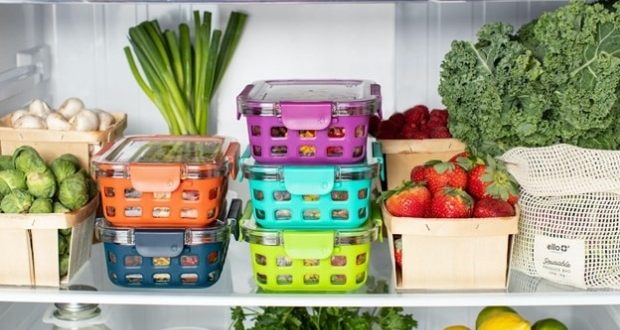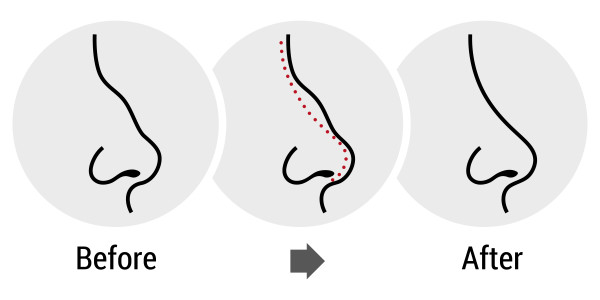November 15th is clean-out your refrigerator day, making it a perfect time to re-evaluate your kitchen knowledge. While many people figure out their own ways to handle food, leftovers, and cooking ingredients, you may be surprised to learn some new things about refrigerator food safety. For these reasons, it may be something to consider when taking inventory of your fridge.
For example, many people eat leftovers well after a week. But did you know that most leftovers shouldn’t be eaten after 3-4 days? This is because refrigeration delays bacteria growth.
Since food is nutrient-dense and filled with moisture, bacteria can develop at a rapid rate. This happens between temperatures of 40 and 140 degrees Fahrenheit. To prevent foodborne illness, it’s best to have a fridge set at 40 degrees Fahrenheit or under. Here’s everything you should know about refrigerator food safety.
Types of Bacteria
When it comes to food, there are usually two main kinds of bacteria. The first is pathogenic, the kind of bacteria that makes you sick. The second is spoilage bacteria, the kind that makes food deteriorate. Spoilage bacteria can also make your food smell foul, change its texture, or taste unpleasant.
What’s important to realize is that outward appearance or taste may not determine longevity. Contrary to popular belief, pathogenic bacteria are usually tasteless.
Since spoilage bacteria develops at low temperatures, theoretically speaking, noticeably spoiled food won’t make you sick (although we don’t recommend taking the risk).
At the end of the day, it comes down to safety versus quality. You can get sick from leaving food on the counter for too long. Yet, food that has been in the fridge for a long time may not taste as well, but it may not make you sick.
Even so, there is a risk of ingesting a bacteria known as Listeria Monocytogenes. These kinds of bacteria thrive in colder temperatures, meaning it’s best to play it safe and throw any spoiled food away.
Proper Fridge Temperature
All refrigerators should be set at 40 degrees Fahrenheit or under. To verify your fridge’s temperature, search for an internal thermometer. If you happen to have a refrigerator without an internal thermometer, keep track of its temperature with an appliance thermometer.
In the event of a power outage, a thermometer is crucial. Food can spoil very quickly in a short amount of time, so it’s essential to keep track of all your perishables when there’s no access to refrigeration.
A general rule of thumb is that no food should be consumed if it’s been sitting above 40 degrees Fahrenheit for more than two hours. Ensure that the fridge door is closed tightly and don’t hold it open for too long.
Handling of Foods for Refrigeration
Hot food can be placed in the fridge after it’s made. If you feel more comfortable with a controlled chill, you can set it in an ice or cold water bath. Even if you choose to put it in the fridge immediately, always cover food to retain moisture and prevent picking up odors from other fridge items.
A large pot of food should be divided into smaller portions and placed in separate containers. This can be helpful when making soups or stews, and Tupperware bins can significantly increase fridge space. Large cuts of meat or whole poultry should be split into smaller pieces and placed in shallow containers.
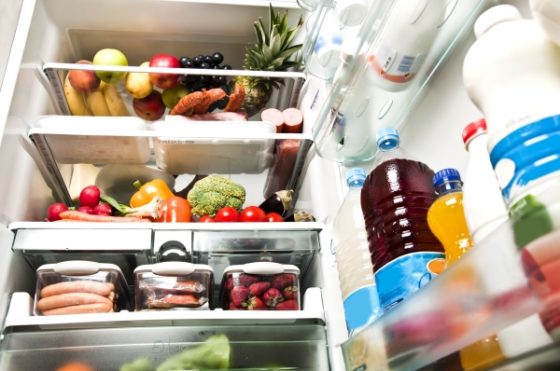
Food Placement
If your fridge has a general temperature of 40 degrees Fahrenheit or under, food should be safe to store anywhere within the appliance. Raw meat, seafood, and poultry should be stored in sealed containers wrapped tightly. With raw meat, it’s also important to prevent raw liquids or juices from contaminating other foods.
Other fridges have unique features that allow you to adjust certain areas of the unit. These can include adjustable shelves, crispers, drawers, and door bins.
These fridges make storage convenient and perfect for veggies, fruit, poultry, cheese, and meats. Never store perishable foods in the door since their temperature will be unpredictable. Even so, keep the door closed as much as possible. Always keep eggs stored in a carton on a shelf, never in the side door or in a drawer.
Fridge Storage
Your fridge should include adjustable shelves. Tempered glass shelves are a great choice since they’re easy to clean and pleasant to the eye. Certain shelves pull out to give you access to the back of the fridge. Your fridge may feature sealed glass shelves that contain spills and make it easier to clean.
Veggies require conditions with higher humidity, while fruits require the opposite. With that said, sealed crisper drawers are a perfect place for fruits and veggies.
Some of these are even adjustable, allowing you to create optimal conditions for your fruits and vegetables. To increase the shelf life of your meats and cheese, order a fridge with adjustable temperature meat drawers.
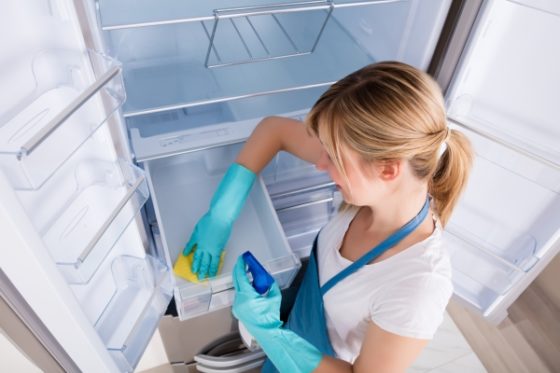
Sanitizing the Fridge
To prevent disease, premature spoiling, or odors, it’s essential to keep your fridge clean. Clean up spills immediately with hot water and soap. When in doubt, follow the manufacturer’s instructions while deciding on a cleaning agent. You want to avoid damaging the interior of your fridge or transferring chemicals into your food.
Make a regular fridge clean part of your routine. Once a week, designate at least 30 minutes to throw out spoiled food. Contrary to popular belief, an average serving of leftovers should only be in the fridge for about 4 days.
This lessens to 1-2 days if it involves ground meats and raw poultry. The fridge’s exterior can be cleaned with dish soap and a soft cloth. Appliance polishes can also be used, and the front grill should be kept clean.
Finally, the condenser coil should be cleaned with a brush or vacuum cleaner to remove any dirt and grime.
Safe Odor Removal
Prevent odors by placing an unopened box of baking soda on a shelf. This can be helpful after a power outage, or something has been sitting in the fridge for too long.
Some other options that you can use include vinegar and water. Vinegar breaks down mildew with acid, reducing musty smells that happen as a result of rotting food.
Use baking soda and water to scrub the inside of the fridge. Afterward, allow the fridge out for several days. One cheap and easy way to remove odors is to sprinkle coffee grounds on the bottom of the fridge or in an open container. Finally, insert a cotton swab with vanilla inside the fridge. Let it sit for 24 hours and remove it in the morning.
Defrosting a Fridge
Most fridges no longer require people to manually defrost the appliance. Most fridges that you purchase today are capable of doing it themselves.
But, in the case of an emergency, power outage, or an older model, here’s what you need to do. Never use an ice pick, sharp object, or electrical heating device to remove frost, which could damage the unit.
Remove any food from the fridge and/or freezer. This can be done by packaging all the food in a cooler and covering it with blankets for insulation. Once the fridge is turned off, keep the removed food cold and prevent frozen foods from thawing.
Fridge Storage Times
Many people create their own time frames for keeping food in the fridge. Yet, many people fail to realize that certain foods, particularly meats, have shorter shelf lives.
Most people keep leftovers in the fridge for about 7 days, but this is a misconception. A good rule of thumb to follow is to remove leftovers after 4 days in the fridge. These are the official storage times determined by the U.S. Department of Agriculture.
Ground Meat
- Ground beef, turkey, veal, pork, lamb: 1-2 days
- Stew meats: 1-2 days
Fresh Meat
- Steaks, chops, and roasts: 3-5 days
- Variety meats (Tongue, kidneys, liver, heart, chitterlings): 1-2 days
Fresh Poultry
- Chicken or turkey, whole: 1-2 days
- Chicken or turkey, parts: 1-2 days
- Giblets: 1-2 days
Bacon and Sausage
- Bacon: 7 days
- Sausage, raw from meat or poultry: 1-2 days
- Smoked breakfast links, patties: 7 days
- Summer sausage labeled “Keep Refrigerated”: Unopened, 3 months; Opened, 3 weeks
- Hard sausage (such as Pepperoni): 2-3 days
Ham and Corned Beef
- Ham, canned, labeled “Keep Refrigerated”: Unopened, 6-9 months; Opened, 3-5 days
- Fully cooked ham, whole: 7 days
- Ham, fully cooked, half: 3-5 days
- Sliced ham, fully cooked: 3-4 days
- Corned beef in a pouch with pickling juices: 5-7 days
Hot Dogs and Lunch Meats
- Hot dogs: Unopened package, 2 weeks; Opened package, 1 week
- Luncheon meats: Unopened package, 2 weeks; Opened package, 3-5 days
Deli Products
- Store-prepared (or homemade) egg, chicken, tuna, ham, and macaroni salads: 3-5 days
- Pre-stuffed pork, lamb chops, and chicken breasts: 1 day
- Store-cooked dinners and entrees: 3-4 days
- Commercial brand vacuum-packed dinners with/USDA seal, unopened: 2 weeks
Cooked Meat, Poultry, and Fish
- Pieces and cooked casseroles: 3-4 days
- Gravy and broth, patties, and nuggets: 3-4 days
- Soups and Stews: 3-4 days
Fresh Fish and Shellfish
- Fresh fish and shellfish: 1-2 days
Eggs
- Fresh, in the shell: 3-5 weeks
- Raw yolks, whites: 2-4 days
- Hard-cooked: 1 week
- Liquid pasteurized eggs, egg substitutes: Unopened, 10 days; Opened, 3 days
- Cooked egg dishes: 3-4 days
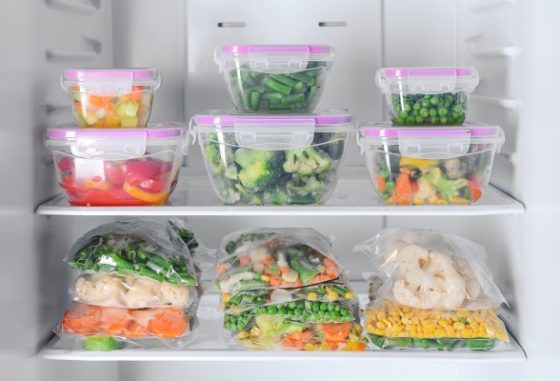
The Four Steps to Food Safety
Clean
Wash surfaces and hands often. Foodborne illness can spread very fast in an unclean kitchen. When washing hands, make sure to do it for 20 seconds with soap and water.
Do this before, during, and after meal preparation. Wash all your dirty dishes with hot, soapy water. Rinse fresh fruits and veggies underwater before ingesting them.
Separate
Never cross-contaminate food. Raw meat, eggs, and seafood carry harmful bacteria that don’t react well with other foods. Keep raw meat of any kind separated from all other foods in the fridge.
Use separate cutting boards and plates when preparing meals that call for raw meat. When grocery shopping, keep raw meat away from the rest of your items to prevent juices from contaminating other food.
Cook
Contrary to popular belief, you can’t rely on color or texture to know if raw meat is cooked. High temperatures kill any harmful bacteria in raw meat, making it essential to cook your food thoroughly. Instead, use a food thermometer and a temperature guide to tell you if your meat is ready.
Chill
After eating, put your leftovers in the fridge as soon as possible. Bacteria can develop rapidly, even if it’s been sitting on the counter for less than 2 hours. If left at the “Danger Zone” (between 40 and 140 degrees Fahrenheit), the risk increases.
Click here to read unhygienic cooking habits to avoid.

